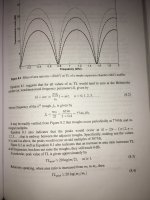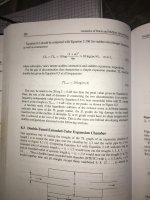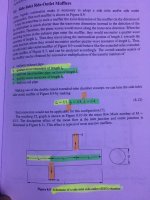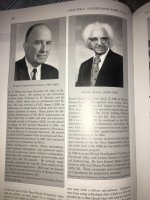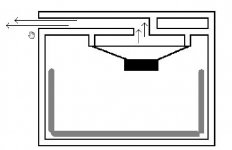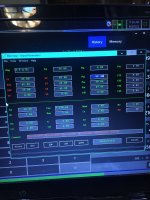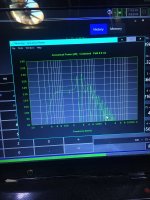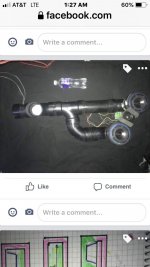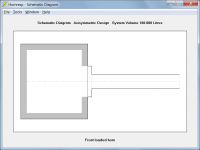martin gave me this book (suggested it when he bought it ) I really wouldn’t know where to begin trying to copy pages that would be helpful because there are so many??
Attachments
860 at 344.0 becomes 864 at 345.6m/sec
look at 8÷2.54, (its 0.0080 more than pi) x 360 is 345.6 in meters and 1133.856… i n ‘imperial’ units (is that even a word?) 🙂
and So are all of 8,4,2,1,0.5,0.25,0.125,0.0625,0.03125(a little similar to pi/2.54?)
16,32,64,128,256,512,1024(all/2.54 to see)
as above so below…(1 is the fulcrum) 3 is the catalyst or fuse? to answers (wavelengths/freq) as numbers can actually be verbs(foreshadowing) if you notice what is hidden in the decimal points already..
11/2.54
22/2.54
44/2.54
88/2.54
176/2.54
352/2.54
This is computer science and encryption codes and so much more but it’s also just hiding in sound and QW resonators right around the corner(345.6m/sec unifies the obvious) from where we usually livehttp://quarter-wave.com/Horns/BLH_Design_Article.pdfThis is computer science and encryption codes and so much more but it’s also just hiding in sound and qw resonators(With added features like driver position precision would we locatewith added features like driver position @ 3 x 1/4 harmonic)
this opens the door for an insane amount of knowledge and understanding of information that otherwise is disguised.
if only There was a way to point out all of this out in great detail by typing it…
…it’s all Larry Olson and Frank Massa it’s just 2020 instead of 1935?
HR never fails if you don’t tell it a bunch of junk !👍🏻💚
look at 8÷2.54, (its 0.0080 more than pi) x 360 is 345.6 in meters and 1133.856… i n ‘imperial’ units (is that even a word?) 🙂
and So are all of 8,4,2,1,0.5,0.25,0.125,0.0625,0.03125(a little similar to pi/2.54?)
16,32,64,128,256,512,1024(all/2.54 to see)
as above so below…(1 is the fulcrum) 3 is the catalyst or fuse? to answers (wavelengths/freq) as numbers can actually be verbs(foreshadowing) if you notice what is hidden in the decimal points already..
11/2.54
22/2.54
44/2.54
88/2.54
176/2.54
352/2.54
This is computer science and encryption codes and so much more but it’s also just hiding in sound and QW resonators right around the corner(345.6m/sec unifies the obvious) from where we usually livehttp://quarter-wave.com/Horns/BLH_Design_Article.pdfThis is computer science and encryption codes and so much more but it’s also just hiding in sound and qw resonators(With added features like driver position precision would we locatewith added features like driver position @ 3 x 1/4 harmonic)
this opens the door for an insane amount of knowledge and understanding of information that otherwise is disguised.
if only There was a way to point out all of this out in great detail by typing it…
…it’s all Larry Olson and Frank Massa it’s just 2020 instead of 1935?
HR never fails if you don’t tell it a bunch of junk !👍🏻💚
Attachments
Last edited:
Harry Olson perhaps, but not Larry...🙂.it’s all Larry Olson, it’s just 2020 instead of 1935?
😝pythagoreum dream(how did he know this??Harry Olson perhaps, but not Larry...🙂.
1496/864/1728 abc
(same c as e a= mC^2)
1496 is the astronomical unit …
sqroot of 3• 864)^2 plus (864)^2
is (864x2)^2.
Attachments
-
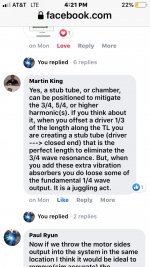 588986A6-4F99-48A9-A037-4616818C8D44.jpeg151.7 KB · Views: 99
588986A6-4F99-48A9-A037-4616818C8D44.jpeg151.7 KB · Views: 99 -
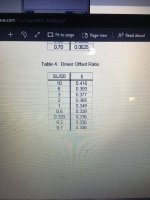 4B72C798-E40B-4A61-984A-AF9084696C6D.jpeg1.3 MB · Views: 180
4B72C798-E40B-4A61-984A-AF9084696C6D.jpeg1.3 MB · Views: 180 -
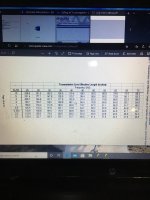 73833A38-6FC4-4DA2-AAFD-22E199D06582.jpeg922.6 KB · Views: 118
73833A38-6FC4-4DA2-AAFD-22E199D06582.jpeg922.6 KB · Views: 118 -
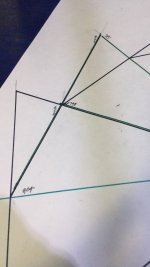 05F22101-EE57-4FD1-8D88-A228ACDCA08F.jpeg347.5 KB · Views: 101
05F22101-EE57-4FD1-8D88-A228ACDCA08F.jpeg347.5 KB · Views: 101 -
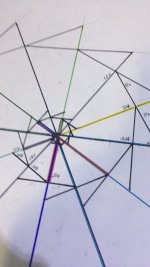 5D5DA4D6-0FB9-4F45-8B21-39C557F1116C.jpeg344.3 KB · Views: 88
5D5DA4D6-0FB9-4F45-8B21-39C557F1116C.jpeg344.3 KB · Views: 88
Last edited:
Yup, that would be excellent.If I understand correctly you would actually like to use the equation L= 6*v*100/(4*Fh) - EC in Step 4, where EC is the end-correction that results from the calculated value of S3. In effect to predict the resulting EC before it is calculated 🙂. I have coded an algorithm to do this and it seems to work fine for both non-tapered and tapered transmission lines. It results in slightly shorter transmission lines as expected, but the values of Vb and Fb are retained. Will this meet your needs?
No, there is no scientific basis for that. The use of 0.341 is just a ratch, an approximation, that seems to result in a better nulling out of the first harmonic than using 0.33. In fact, I won't be surprised if a more accurate location would be 0.33 plus the end-correction (or some computed part of it), LOL.Also, are you happy for the offset ratio value to be slightly changed to Pi / 9, as suggested by Booger weldz?
If you've got an algorithm for working it out (mentioned in post 12,938), I suggest we use that.The theoretical end-correction for S3 unflanged is 0.61*R3.
The theoretical end-correction for S3 flanged is 0.85*R3.
Are you happy to still use 0.8*R3 as the end-correction, where R3 is the radius of S3?
Looks to me like a 4th order bandpass with very small front chamber!Looks like a kind of closed box and front loaded design with a very small outlet in stead of a flare like
in a horn..
Was about to post Martin King's similar reply from the Facebook group 👍🏼My curiosity got the better of me - I couldn't resist sending an email to Martin asking him why he changed methods 🙂. I found his reply to be very informative and interesting, and he has kindly given me permission to share it with everyone here.
As a result of Martin's reply and for the sake of completeness I am now thinking of adding other Vance Dickason tables to Method MK 2021, and allowing the user to choose which table they want.
////////////////////////////////////////////////////////////////////////////
"The older alignment tables tended to produce a very large enclosure compared to a bass reflex design, they lived along a very narrow design curve. The newer alignment tables produce an enclosure that is the same size as the equivalent BR enclosure designed from the LDC alignment tables, this to me is a big advantage. Also using the LDC BR alignment tables a lot more potential geometries are available that produce different enclosure volumes by accounting for different alignments (BB4, SC4, and QB3) as well as different amounts of box losses QL. I also found for the larger enclosures designed using the original alignment tables that when you start adding fiber stuffing the results tend to move towards the smaller LDC BR alignment table results with the same stuffing density so there was no real advantage to the larger enclosure.
The two sets of alignment tables (2006 and 2021) can both be used to design a TL enclosure, but I much prefer the newer method."
////////////////////////////////////////////////////////////////////////////
ready to construct an ‘adjustable’ entry TL to locate this for ‘real’ if a satisfactory method is suggested? sleeved abs/PVC pipe in sched40 3” and 4” are within 0.00x “ of OD/ID and umm6 can grab the results ?Yup, that would be excellent.
No, there is no scientific basis for that. The use of 0.341 is just a ratch, an approximation, that seems to result in a better nulling out of the first harmonic than using 0.33. In fact, I won't be surprised if a more accurate location would be 0.33 plus the end-correction (or some computed part of it), LOL.
Unless you can think of a good reason not to, I would like to use L12 = (L13 + EC) / 3 rather than L12 = 0.341 * L13 to calculate the driver offset. Interestingly, the new formula still gives an offset ratio very close to 0.341 in all cases (both tapered and non-tapered).The use of 0.341 is just a ratch, an approximation, that seems to result in a better nulling out of the first harmonic than using 0.33.
Sanity check of new algorithm:I have coded an algorithm to do this and it seems to work fine for both non-tapered and tapered transmission lines.
If:
Vb = 87 litres
Fb = 26 Hz
BW = 10
Then the new algorithm calculates:
Fh = 260 Hz
L13 = 193.93 cm
S3 = 89.72 cm^2
EC = 4.53 cm (for S3 of 89.72 cm^2)
OR = 0.341
Given:
L = 6 * v * 100 / (4 * Fh) - EC
Then:
L = 6 * 344 * 100 / (4 * 260) - 4.53
L = 193.93 cm
Because the value of L is the same as that of L13 calculated above, it means that the algorithm is working correctly 🙂.
Any remaining small differences between the required and actual Fb in a tapered system are most likely due to the
S1/S= ROUND(0.0046*BW^3-0.1483*BW^2+1.6776*BW-4.7182,1) mapping formula not being exactly correct.
Brian, are you happy for your method (with my minor tweaks) to be released as it now currently stands?
Hi Kees,Looks like a kind of closed box and front loaded design with a very small outlet in stead of a flare like in a horn..
That's what it looks like to me also.
Kind regards,
David
Attachments
Looks good to me....Unless you can think of a good reason not to, I would like to use L12 = (L13 + EC) / 3 rather than L12 = 0.341 * L13 to calculate the driver offset. Interestingly, the new formula still gives an offset ratio very close to 0.341 in all cases (both tapered and non-tapered).
Yup, looks fine to me. I'll have to run it through a bunch of sims with different drivers to confirm, but it looks fine at the moment.Brian, are you happy for your method (with my minor tweaks) to be released as it now currently stands?
please build one 🤷 we’re traveling down a precarious road hereYup, looks fine to me. I'll have to run it through a bunch of sims with different drivers to confirm, but it looks fine at the moment.
This has been a great collaboration resulting in a very useful and powerful new tool for Hornresp, elegant in its simplicity of operation. Hopefully others following the discussion may have found it interesting also. Thank you for your persistence in not giving up when at times it seemed that what you were trying to achieve might be impossible 🙂.Yup, looks fine to me.
It may take a little time before the new update is released. Coding and functionality still have to be finalised, and parts of the Help file will need revising.
Why precarious?we’re traveling down a precarious road here
- Home
- Loudspeakers
- Subwoofers
- Hornresp

